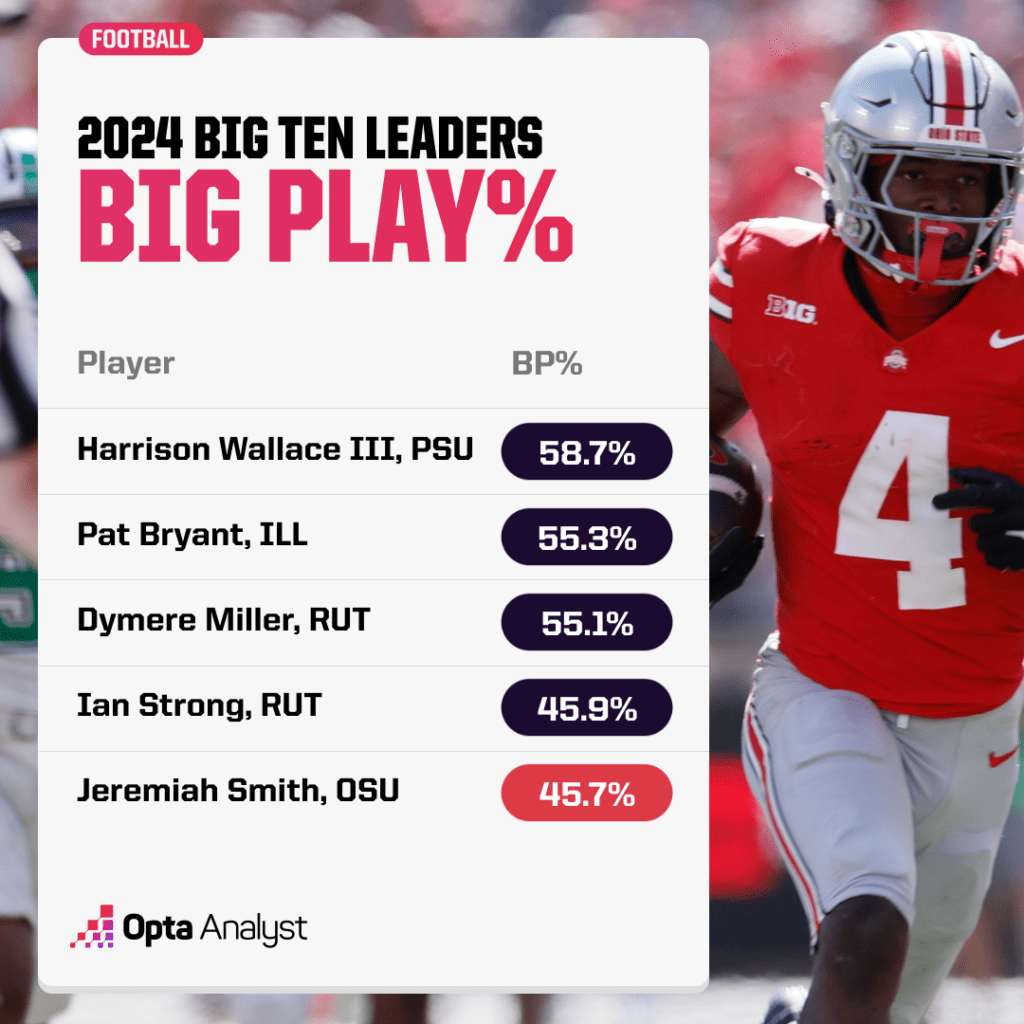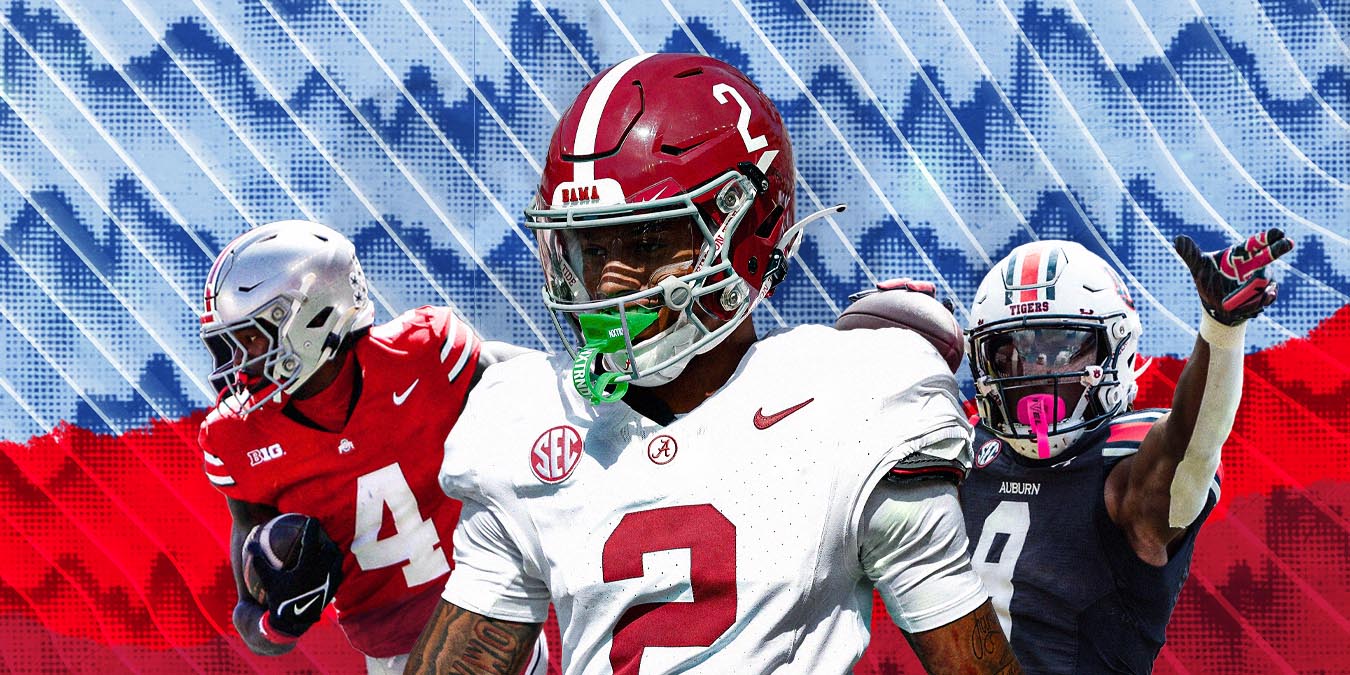Some are calling 2024 college football’s year of the freshman wide receiver. That’s because several entered the season with lofty expectations. We check in on how some are faring.
It’s not often that a true freshman wide receiver plays a major role in college football’s national championship race.
It last happened in 2017, when Alabama’s DeVonta Smith ended the season by catching a 41-yard touchdown to beat Georgia in overtime. And even then, Smith’s season is remembered for one historic moment, not for production over the whole year.
Smith wrapped his freshman season with 160 receiving yards, driving home the reality that even for a consensus five-star prospect and eventual Heisman Trophy winner, it’s hard to crack the field as a freshman, let alone make national waves.
In 2024, a couple of freshmen are making it look easier than it really is.
Alabama’s Ryan Williams doesn’t turn 18 until after the season, but he’s emerged as the most important target for a Crimson Tide program that looks like a College Football Playoff team in Kalen DeBoer’s first season. Ohio State’s Jeremiah Smith is already the best receiver on a team many expect to win the title.
As if to remind everyone else just how hard it is to be this good this fast, other very hyped freshmen five-stars like Auburn’s Cam Coleman and Texas Tech’s Micah Hudson are struggling to produce or even get on the field.
A lot of teams were set to lean heavily on freshmen wideouts this fall, and only a few have had it work out. Let’s take a spin from the early success stories affecting the playoff race to the cases where it looks like mega-talented recruits have a long way to go.
Enjoy Them While They’re In College
Ryan Williams, Alabama
Williams prefers large bills. His 17.2-yard average depth of target is fifth in the SEC, as he’s mostly worked so far as an outside receiver stretching the field for quarterback Jalen Milroe.
Williams has been a big producer, catching 10 of his 13 targets for 285 yards and becoming the Tide’s leading receiver by more than double the next closest man. Four of his catches have gone for touchdowns, and the next game in which Williams doesn’t record a catch of 43 yards or longer will be his first.
Are you ready to be annoyed? Good.
Williams has a lot of room to get better yet. His 53.8% burn rate is well below the SEC and national average, even as an 84.6% open rate suggests DeBoer and company have done a good job getting him open (well above the 77.7% Power-Four average).
Look at Williams’ production so far, and then imagine what he would be like if he got a bit better at shaking loose the poor defenders trying to cover him. A version of Williams that did not even have to bother with contested catches would not be fair.
Jeremiah Smith, Ohio State
Ohio State hasn’t played serious competition yet, but Smith has looked so dominant that few people would dare be skeptical about how good he’s been.
Against non-power competition over the first three weeks, he caught 14 of his 17 targets for 281 yards and four touchdowns. Smith wasn’t quite unrecoverable, as a Marshall cornerback demonstrated in Week 3 when he ran stride-for-stride with the five-star WR and intercepted a deep ball from Will Howard.
But some recruiting evaluators felt Smith was the best receiver prospect they had ever seen when he came out of South Florida, and nothing he’s done so far has made that look wrong.
Smith hasn’t had any blockbuster plays yet, by the standards he’s likely to set over his career. However, he’s made high-level receiver moves look so, so easy, whether controlling the ball to set up a run after the catch or effortlessly corralling back-shoulder fades.
Smith’s 78.6% burn rate is eighth among Big Ten receivers, while his 45.7% big play rate is fifth. He is, simply put, good.

Looking Like a Pretty Big Future Star
Nick Marsh, Michigan State
Marsh was a heralded recruit, but not like the headliners we’ve looked at. He was a regular old four-star prospect out of Detroit, and new Michigan State coach Jonathan Smith managed to wrap him up in his first few weeks after coming over from Oregon State.
It’s a good thing Smith did. In just his second college game, Marsh dominated Maryland all afternoon and caught a 77-yard touchdown in the fourth quarter that tied the game and paved the way for a comeback win. Marsh’s 194-point output in that game is still just about his whole college output; he combined for three catches and 38 yards in his other two games.
But as MSU comes out of a bye this week and faces Ohio State, Marsh is a breakout candidate.
Marsh has posted a 78.6% burn rate, compared to a Big Ten average of 66.0%. He’s averaged 13.9 yards of target depth, 3 yards ahead of league average. His 1.01 expected yards per target are 10th in the league, and his 15.5 actual yards per target are even better.
Marsh is a good route runner who catches tough balls and averages an excellent 7.3 yards after the catch.
Bryant Wesco Jr., Clemson
Clemson’s first week of the season brought a humiliating loss to Georgia, another data point that drove home how far the Tigers are from the sport’s best programs. But in the second game of the season against Appalachian State, the Tigers started to get the five-star freshman Wesco involved.
After one catch for 5 yards in the opener, he had three for 130 against App State and gave Clemson fans a bit of optimism at a bleak moment for the program.
The sample size here remains small, and Wesco followed the App State breakout with one catch for minus 1 yard in a blowout of NC State. But he’s averaged 8.0 burn yards per target on his six targets so far – best on the team – while getting open on five of those routes.
At a 14.2-yard average target depth, he’s been one of three real deep threats on the roster alongside Antonio Williams and Tyler Brown. It’s been a few years since Clemson has had an elite wideout, but Wesco has a nice chance to be next.
Turns Out College Football Is Hard
Cam Coleman, Auburn/Micah Hudson, Texas Tech
Let’s take these two players together, because there are different ways to fall on hard time early in one’s college career. A team can make a player the focal point of the offense when he’s not quite ready, or a team can just decline to put a talented player on the field.
As two of the most touted recruits in the history of their programs, Coleman and Hudson demonstrate these two paths.
Coleman has suffered from catching passes from struggling quarterback Payton Thorne. But he also hasn’t performed well himself, missing a game due to injury and returning last week against Cal to let a routine slant bounce off his hands and go for an interception.
Coleman has had exactly two catches in each of the three games he’s played, and while he had 40-plus yarders in his first two appearances against Alabama A&M and Cal, he was essentially a non-factor in a loss to Arkansas in Week 4.
His 72.7% burn rate is above average, but how good can Coleman be as long as Auburn lacks a competent passer?
His start has been better than Hudson’s. It’s not a stretch to say that Hudson, another five-star recruit, was the most sought-after commitment in Texas Tech history. But he has evidently not shown much in practice, because coach Joey McGuire has barely used him.
Hudson has run all of 22 receiver routes and received six targets in his first month of college, catching five of them for 47 yards. His lone true highlight was a near-touchdown on a garbage-time slant route against an awful North Texas defense in Week 3.
On those precious few targets, Hudson has a lousy 33.3% burn rate and a depth of target of just 4.3 yards.
Better days are ahead, but he’s a reminder of how great Williams and Smith are so early in their careers.
Be sure to check out our MLB, NBA, NFL and college football coverage. And follow us on X and Instagram for more!
